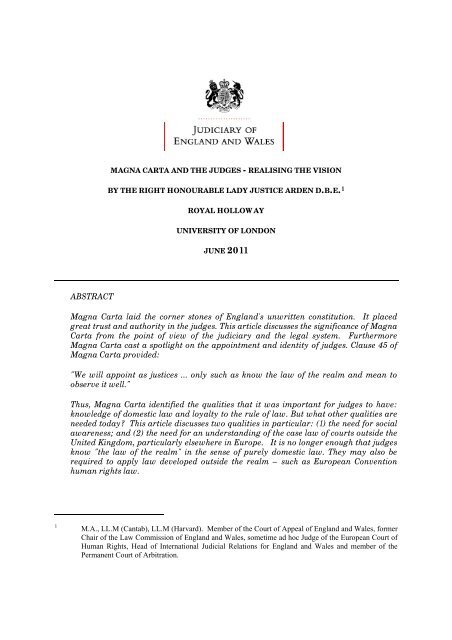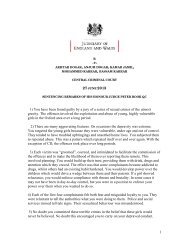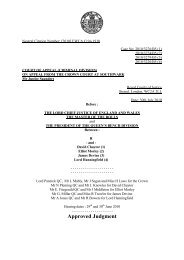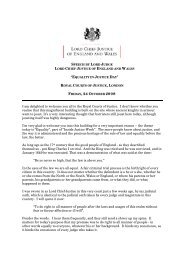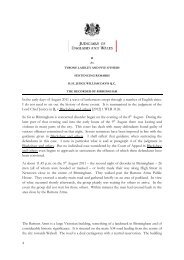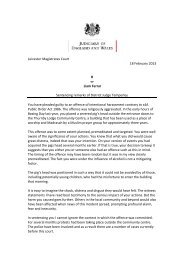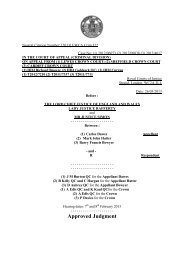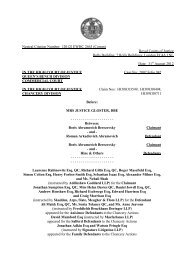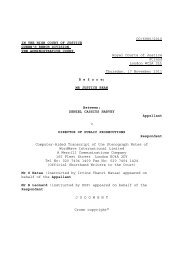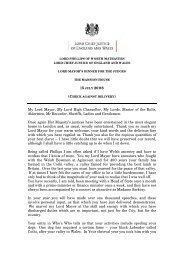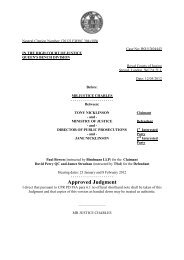Lady Justice Arden speech: Magna Carta Lecture - Judiciary
Lady Justice Arden speech: Magna Carta Lecture - Judiciary
Lady Justice Arden speech: Magna Carta Lecture - Judiciary
You also want an ePaper? Increase the reach of your titles
YUMPU automatically turns print PDFs into web optimized ePapers that Google loves.
ABSTRACT<br />
MAGNA CARTA AND THE JUDGES - REALISING THE VISION<br />
BY THE RIGHT HONOURABLE LADY JUSTICE ARDEN D.B.E. 1<br />
ROYAL HOLLOWAY<br />
UNIVERSITY OF LONDON<br />
JUNE 2011<br />
<strong>Magna</strong> <strong>Carta</strong> laid the corner stones of England's unwritten constitution. It placed<br />
great trust and authority in the judges. This article discusses the significance of <strong>Magna</strong><br />
<strong>Carta</strong> from the point of view of the judiciary and the legal system. Furthermore<br />
<strong>Magna</strong> <strong>Carta</strong> cast a spotlight on the appointment and identity of judges. Clause 45 of<br />
<strong>Magna</strong> <strong>Carta</strong> provided:<br />
"We will appoint as justices ... only such as know the law of the realm and mean to<br />
observe it well."<br />
Thus, <strong>Magna</strong> <strong>Carta</strong> identified the qualities that it was important for judges to have:<br />
knowledge of domestic law and loyalty to the rule of law. But what other qualities are<br />
needed today? This article discusses two qualities in particular: (1) the need for social<br />
awareness; and (2) the need for an understanding of the case law of courts outside the<br />
United Kingdom, particularly elsewhere in Europe. It is no longer enough that judges<br />
know "the law of the realm" in the sense of purely domestic law. They may also be<br />
required to apply law developed outside the realm – such as European Convention<br />
human rights law.<br />
1 M.A., LL.M (Cantab), LL.M (Harvard). Member of the Court of Appeal of England and Wales, former<br />
Chair of the Law Commission of England and Wales, sometime ad hoc Judge of the European Court of<br />
Human Rights, Head of International Judicial Relations for England and Wales and member of the<br />
Permanent Court of Arbitration.
INTRODUCTION<br />
In this study of <strong>Magna</strong> <strong>Carta</strong>, I wish to focus on the role of the judges, the vision which<br />
<strong>Magna</strong> <strong>Carta</strong> had for them and how it is to be realised today – 800 years on. This is a<br />
topical subject because, since the last centenary of <strong>Magna</strong> <strong>Carta</strong> in 1915, we have had, all<br />
within the last half century, at least three statutes of great significance to the<br />
constitutional framework of the UK – the European Communities Act 1972, the Human<br />
Rights Act 1998 and the Constitutional Reform Act 2005. In addition, we currently have<br />
two major high-level inquiries of particular interest and importance in relation to the<br />
judicial function, namely, the Commission on a UK Bill of Rights and the inquiry of the<br />
House of Lords Constitution Committee into the judicial appointments process. I do not<br />
propose to discuss what these two inquiries may show or may recommend. What I wish<br />
to examine is the context in which these inquiries arise. They are building on the<br />
foundations which <strong>Magna</strong> <strong>Carta</strong> laid.<br />
796 years ago King John, acceding to the demands of the Barons, set the Great Seal of<br />
England on the Charter of Liberties we now call <strong>Magna</strong> <strong>Carta</strong> "in the meadow which is<br />
called Runnymede, between Windsor and Staines."<br />
In the years which followed, <strong>Magna</strong> <strong>Carta</strong> was confirmed over thirty times by royal<br />
charter; it was directed to be read out twice yearly in the great cathedrals of the land;<br />
archbishops and bishops were directed to pronounce sentences of excommunication on<br />
those who by word, deed or counsel went against the Charter; and Kings were expected<br />
to confirm <strong>Magna</strong> <strong>Carta</strong> at the start of their reign. This gives us some idea of <strong>Magna</strong><br />
<strong>Carta</strong>'s importance in mediaeval England. Not all of the provisions of the document<br />
signed by King John were reconfirmed but most were and indeed some of the clauses<br />
remain the law of the land.<br />
In this study, I propose to examine an aspect of <strong>Magna</strong> <strong>Carta</strong> which, as far as I know, has<br />
not been examined before, at least not in the course of this series of <strong>Magna</strong> <strong>Carta</strong><br />
2
lectures. I propose to examine the role which <strong>Magna</strong> <strong>Carta</strong> assigned to the judges, and<br />
ask whether the features of the judicial role envisaged by <strong>Magna</strong> <strong>Carta</strong> have changed and<br />
how they are being realised today.<br />
To do this, I have to start by exploring the significance of <strong>Magna</strong> <strong>Carta</strong> from the point of<br />
view of the law and the administration of justice by the judges. I propose to concentrate<br />
on the following clauses:<br />
"(17) Ordinary lawsuits shall not follow the royal court around, but shall be held in a<br />
fixed place.<br />
…<br />
(39) No free man shall be seized or imprisoned, or stripped of his rights or possessions,<br />
or outlawed or exiled, or deprived of his standing in any other way, nor will we<br />
proceed with force against him, or send others to do so, except by the lawful<br />
judgment of his equals or by the law of the land.<br />
(40) To no one will we sell, to no one deny or delay right or justice.<br />
…<br />
(45) We will appoint as justices, constables, sheriffs, or other officials, only men that<br />
know the law of the realm and are minded to keep it well."<br />
Clause 45 did not appear in later versions of <strong>Magna</strong> <strong>Carta</strong> after 1215, and clause 40 was<br />
renumbered as clause 29 in at least one later version, but nothing turns on these points<br />
for present purposes. Clauses 39 and 40 are still in force today by virtue of the Charter<br />
of 1225.<br />
WHAT WAS THE SIGNIFICANCE OF THESE FOUR PROVISIONS OF<br />
MAGNA CARTA?<br />
<strong>Magna</strong> <strong>Carta</strong> is a monumental affirmation of the rule of law. It proceeds on the all-<br />
important assumption that disputes are to be decided in accordance with the law. This<br />
was not a new idea but an important confirmation of it. As Lord Irvine LC put it, "[t]he<br />
3
primary importance of <strong>Magna</strong> <strong>Carta</strong> is that it is a beacon of the rule of law." 2 Laws LJ has<br />
described <strong>Magna</strong> <strong>Carta</strong> as a "proclamation of the rule of law". 3 The King was not above<br />
the law and he could not displace the due application of the law by his judges. Moreover,<br />
by providing for the judicial determination of disputes according to the law of the land,<br />
<strong>Magna</strong> <strong>Carta</strong> laid the foundations of what we know today as due process of law. It also<br />
gave judges what has been their traditional and vital role of acting as a bulwark for the<br />
individual against arbitrary action by the state. The concept of due process is an element<br />
within the concept of the rule of law.<br />
This is not the place for a detailed exposition of the concept of the rule of law, which may<br />
be found instead in Lord Bingham's remarkable book, The Rule of Law. 4 In a <strong>speech</strong><br />
which he gave on <strong>Magna</strong> <strong>Carta</strong>, 5 Lord Bingham summed up its achievements in these<br />
terms:<br />
“Conditioned as we are today by our own knowledge of political and<br />
constitutional development over the last nine centuries, it calls for the<br />
exercise of real historical imagination to appreciate the enormity, the<br />
grandeur of what was done at Runnymede. King John entered the meadow as<br />
a ruler acknowledging no secular superior, whose word was law. He left the<br />
meadow as a ruler who had acknowledged, in the most solemn manner<br />
imaginable, that there were some things even he could not do, at any rate<br />
without breaking his promise. This, then, is the enduring legacy of <strong>Magna</strong><br />
<strong>Carta</strong>: the lesson that no power is absolute; that all power, however elevated,<br />
is subject to constraint; that, as was to be said by Dr. Thomas Fuller some<br />
centuries later, "Be you never so high, the law is above you".”<br />
In addition, there is significance in the fact that clause 17 provided that the judges were<br />
to sit in a fixed place. This court became the Court of Common Pleas, as opposed to the<br />
Court of the King's Bench, which followed the King around the country, and as opposed<br />
2 The Spirit of <strong>Magna</strong> <strong>Carta</strong> continues to resonate in Modern Law (2003) 119 LQR 227.<br />
3<br />
R (on the application of Bancoult) v Secretary of State for Foreign and Commonwealth Affairs<br />
[2001] QB 1067 at [36].<br />
4 Allen Lane Publishers, 2010.<br />
5 To be published in a collection of Lord Bingham’s essays by Oxford University Press.<br />
4
to the Court of Chancery. The Court of Common Pleas existed down to the end of the<br />
nineteenth century. The fact was that, before <strong>Magna</strong> <strong>Carta</strong>, the King often took the<br />
decisions in disputes between his subjects as he went around the country, without<br />
involving his judges, or his judges made the decisions but applied the lex regni.<br />
Putting the judges into a fixed place, away from the King, achieved two ends in<br />
particular. First, it laid the foundation for the doctrine of separation of powers. Judges<br />
were to be separate from the King, who made laws by royal decree. The doctrine of<br />
separation of powers has been much debated and developed in the eight centuries since<br />
<strong>Magna</strong> <strong>Carta</strong>. The separation was only gradual: at least until the end of the eighteenth<br />
century judges could be members of Parliament as well as holding judicial office. Most<br />
recently, the doctrine was invoked as the principal reason for setting up the new Supreme<br />
Court of the United Kingdom pursuant to the Constitutional Reform Act 2005. The<br />
Supreme Court replaced the House of Lords, which had been the highest court in the<br />
land since 1399, although the concept of the Lords of Appeal in Ordinary only came<br />
about pursuant to the Appellate Jurisdiction Act 1876. Secondly, the separation of judges<br />
from the King's court made clear that judges were to operate independently of the King.<br />
This led to the development of the concept of judicial independence.<br />
Clause 45 provides that the judges were to apply the law of the realm. What was the<br />
significance of that? It was the law of the realm as opposed to the law of the King, canon<br />
law or local law. I have already explained that some judges were attached the royal court.<br />
Other judges were people in the locality who were trusted by the local inhabitants to try<br />
disputes or to hear criminal cases. There were, of course, no professional judges. The<br />
judges were often priests and so they were very familiar with canon law, which was<br />
5
derived from Roman law. 6 The significance of requiring judges to apply the law of the<br />
realm was that they would have to apply the law that was built up by tradition and<br />
accepted by the population. So the law of the realm was the law of England, including<br />
the law applied by local custom in different areas of England. Significantly, the law of the<br />
realm was the law of the people or, as it was and is called: the common law. As it was put<br />
in a work known as The Mirror of the <strong>Justice</strong>s published in about 1290, it is called<br />
common law "because it is given to all in common". 7 This emphasis on commonality<br />
suggests that the common law is a system of law in which all members of society are to<br />
have a share.<br />
Moreover, <strong>Magna</strong> <strong>Carta</strong>, by requiring judges to apply the law of the realm, authorised the<br />
judges to apply the common law. This was an enormous shift of power away from the<br />
King and to the judges. In the fullness of time, the authority to apply the common law<br />
was taken to include the authority to develop the common law, but the judges had to<br />
exercise restraint. They adopted a theory known as the declaratory theory of the<br />
common law. They were loath to admit that they were developing the common law, and<br />
instead expressed themselves as simply declaring common law which had previously lain<br />
hidden. This theory continued for many hundreds of years: only comparatively recently<br />
has it been said that judges "do not believe in fairy tales anymore, so we must accept that<br />
for better or worse judges do make law." 8 It is, therefore, no longer denied that judges<br />
are developing the law but this is always subject to Parliamentary sovereignty. The<br />
judges cannot develop the law so that it contradicts a statute; nor do they develop the law<br />
in an area that ought properly to be left to Parliament, for example, because to lay down<br />
the law needs more than the judges can do by judicial decision in a particular case.<br />
6<br />
Roman law and canon law may also have had an influence on the drafting of <strong>Magna</strong> <strong>Carta</strong>: see R.M.<br />
Helmholz, <strong>Magna</strong> <strong>Carta</strong> and the ius commune (1999) 66 University of Chicago Law Review 297.<br />
7<br />
Book I (Of Sins Against The Holy Peace), Chapter 1 (Of the Generation of Holy Law).<br />
8<br />
Lord Reid, The Judge as Lawmaker, (1972) 12 Jnl Soc Public Teachers of Law 22.<br />
6
Furthermore, by providing that any interference with an individual's liberty had to be<br />
authorised by the law of the land, 9 which was to be applied by the judges, <strong>Magna</strong> <strong>Carta</strong><br />
expressly recognised something that it is today easy to take for granted but which is<br />
utterly fundamental, namely that every person should have the right not to have his<br />
liberty taken away other than in accordance with a decision of a court and due process of<br />
law. Clause 39 outlawed detention by order of the King or, in more modern terms, mere<br />
executive detention, not prescribed by law, for whatever reason.<br />
And, by providing for the judicial determination of disputes, <strong>Magna</strong> <strong>Carta</strong> laid the<br />
foundations of certainty and consistency in the law and for the law to be administered in<br />
a public place, thus laying the foundations of open justice for all.<br />
The provision in clause 40 that justice would not be sold or delayed was also a vitally<br />
important guarantee in all courts, even in the King’s Bench and the Court of Chancery.<br />
However, in parenthesis, it should be noted that this clause was never applied to the sale<br />
of writs, which was an important source of revenue for many Kings. This is an<br />
opportunity which has not escaped elected governments in recent times as court fees<br />
have been substantially increased for the Treasury's benefit. However, court fees cannot<br />
be of such an amount as to bar a person from obtaining access to a court. 10<br />
As to the barons who caused King John to apply the Great Seal to <strong>Magna</strong> <strong>Carta</strong>, it is of<br />
course impossible to believe that they had any idea of the epic nature of the act on which<br />
they were engaged. They were, almost certainly, seeking to protect their own rights and<br />
interests against excessive royal power, and possibly even to put themselves above the<br />
law. It is now generally accepted that when clause 39 refers to the judgment of a person<br />
9<br />
The only exception in clause 39 was for “the lawful judgment of his equals”, which is considered<br />
below.<br />
10<br />
R (on the application of Witham v Lord Chancellor [1998] QB 575.<br />
7
y his peers, it is in fact referring to the judgment of the barons by the barons, and not to<br />
trial by jury. But, once it became accepted, as it did, that it was not just the barons but<br />
every free person who was entitled to the protection of <strong>Magna</strong> <strong>Carta</strong>, the parallel with<br />
trial by jury was obvious. It is also to be noted that clause 40 was not the source of<br />
habeas corpus, which was a remedy developed by the judges.<br />
<strong>Magna</strong> <strong>Carta</strong> was originally called the Great Charter, not because of its contents, but<br />
because it was executed contemporaneously with a shorter document called the Charter<br />
of the Forest. Its execution did not mean that all was sweetness and light afterwards.<br />
Kings continued to err. In addition, the legal system did not meet all the high ideals<br />
which <strong>Magna</strong> <strong>Carta</strong> suggested that it should. Thus, for instance, the Tudors established<br />
the Court of Star Chamber 11 , which acted as an immediate agent of the King's<br />
prerogative 12 . The tyrannical proceedings of the Star Chamber under the Stuarts,<br />
especially Charles I, in political cases led to its abolition in 1641 by an Act of Parliament<br />
that referred to <strong>Magna</strong> <strong>Carta</strong> and stated that cases "ought to be tried and determined in<br />
the ordinary courts of justice, and by the ordinary course of law". 13 Trial methods in<br />
ordinary courts did not meet modern standards either, since trial by ordeal and trial by<br />
battle were for many years the order of the day. But, over time, the ideals of <strong>Magna</strong> <strong>Carta</strong><br />
became embedded.<br />
Of course, no mention is made of the relationship of the common law to statute law. That<br />
Great Council of the nation, known as Parliament, had not yet been been convened. 14<br />
When it was, it became accepted that the common law should be subject to the will of<br />
11<br />
Established by the Act of 1487 (3 Henry VII. C.I.), the Act of Pro Camera Stellata.<br />
12<br />
Sir William Holdsworth, A History of English Law (7 Ed., 1956), Sweet & Maxwell, Vol. 1 at p 495.<br />
13<br />
14<br />
16 Charles I. C. Ss 4 and 5.<br />
This occurred later in the thirteenth century, particularly with the convening by Simon de Montfort of<br />
Parliaments in 1264 and 1265: see generally, K Mackenzie, The English Parliament (Pelican, 1950).<br />
8
Parliament. The doctrine of Parliamentary sovereignty, as it is now known, is explored<br />
by Lord Bingham in a <strong>speech</strong> which he gave in King's College, London in October 2007. 15<br />
I pose the question: why was <strong>Magna</strong> <strong>Carta</strong> so significant for the role of judges and the<br />
administration of justice in England? Quite simply, the <strong>Magna</strong> <strong>Carta</strong> laid the<br />
foundations for some of the most fundamental concepts of our legal system. These<br />
concepts echo two major themes, which overlap. The first theme may be called the<br />
constitutional theme, and it involves:<br />
1. The separation of powers;<br />
2. The birth of the judiciary as a separate arm of the constitution<br />
of England;<br />
3. The independence of the judiciary;<br />
4. The incorruptibility of the judiciary; and<br />
5. The development of the common law, based in theory on long<br />
tradition but in reality representing judge-made law.<br />
There is a second, equally important, theme based on the role of the individual in<br />
relation to the state, involving:<br />
1. The judiciary as the bulwark of individual liberty against<br />
arbitrary action by the state;<br />
2. The rule of law;<br />
3. Equality before the law;<br />
4. Due process;<br />
5. Open justice; and<br />
15 Lord Bingham of Cornhill, The Rule of Law and the Sovereignty of Parliament, King's College,<br />
London, 31 October 2007, available at:<br />
http://www.kcl.ac.uk/news/news_details.php?news_id=672&year=2007<br />
9
6. Certainty and consistency in the law.<br />
The second theme then is all about liberty and, it might be said, the first theme is the<br />
framework which allows the second theme to flourish. Liberty begins historically with<br />
liberty of the person in the sense of freedom from arbitrary arrest. It has been developed<br />
over the centuries to include other freedoms, such as freedom of expression and freedom<br />
of self-realisation. Most recently, it has been developed in terms of respect for one's<br />
home and private life.<br />
<strong>Magna</strong> <strong>Carta</strong> thus gave us fundamental law. It is little wonder that we call this the Great<br />
Charter of our Liberties.<br />
It is not within the scope of this study of <strong>Magna</strong> <strong>Carta</strong> to explore the ways in which the<br />
provisions of <strong>Magna</strong> <strong>Carta</strong>, which I have set above, have found their way into the written<br />
constitutions of many democracies around the world but I will give one example, where it<br />
finds particularly clear expression: the Fourteenth Amendment of the Constitution of the<br />
United States, which reads:<br />
"XIV. Section 1. … [N]or shall any State deprive any person of life, liberty, or<br />
property, without due process of law; nor deny to any person within its<br />
jurisdiction the equal protection of the laws."<br />
<strong>Magna</strong> <strong>Carta</strong> also finds clear reflection in the International Convention on Civil and<br />
Political Rights, 16 the Universal Declaration of Human Rights, 17 and the European<br />
16 See, for example, article 9(1), which provides: “Everyone has the right to liberty and security of person.<br />
No one shall be subjected to arbitrary arrest or detention. No one shall be deprived of his liberty except<br />
on such grounds and in accordance with such procedure as are established by law.”<br />
17 See, for example, article 9, which provides: “No one shall be subjected to arbitrary arrest, detention or<br />
exile.”<br />
10
Convention on Human Rights. 18 <strong>Magna</strong> <strong>Carta</strong> belongs today, not only to England, but to<br />
the world.<br />
However, <strong>Magna</strong> <strong>Carta</strong>'s high ideals depend on there being a plentiful supply of persons<br />
capable of acting as judges and enforcing the rights which it guaranteed, including the<br />
rights conferred by the common law. That leads naturally to the question to which I next<br />
turn, which is: what are the qualities required of judges?<br />
QUALITIES REQUIRED OF JUDGES TODAY<br />
To start with a very basic point, the office of judge is a public office, which must be<br />
discharged in the public interest. It is thus important continually to review the qualities<br />
that judges require in order to discharge their role.<br />
It is obvious that certain qualities are required of all judges. These include utter<br />
integrity, legal skill and knowledge, sound judgement, courage, an independent cast of<br />
mind and an ability to act fairly.<br />
There are also additional qualities required of judges according to the nature of their case<br />
load. Criminal judges, for example, need to be able to sum up to juries clearly and<br />
correctly, and to deal with problems arising within a jury trial. Nowadays, many judges<br />
also need to have administrative skills. Others have responsibilities in connection with<br />
the organisation of the legal system and keeping the rules of procedure under review,<br />
dealing with judicial discipline and so on. Judges play an important part in ensuring the<br />
efficient delivery of justice, at a reasonable price, to litigants and society. But not all<br />
18 See, for example, article 5(1), which provides: “Everyone has the right to liberty and security of person.<br />
No one shall be deprived of his liberty save in the following cases and in accordance with a procedure<br />
prescribed by law: (a) the lawful detention of a person after conviction by a competent court…”<br />
11
judges are required to have administrative and organisational skills. Some will be<br />
thinkers and concentrate on developing the law and seeing the big picture.<br />
These are judicial qualities that are well understood and regularly discussed. The<br />
Judicial Appointments Commission website sets out many of the important qualities.<br />
But there are two other qualities which are not so often mentioned and which, it seems to<br />
me, need to be brought to the fore:<br />
(1) The need for judges to have an awareness of the background to the problems they<br />
are likely to have to deal with, which one might term “social awareness”; and<br />
(2) The need for senior judges to have an understanding of the case law of courts<br />
outside the UK, particularly elsewhere within the Europe.<br />
Additional Quality One: Social Awareness<br />
The first additional judicial quality I wish to discuss is consciousness of the social context<br />
in which decisions have to be made today. This is often said to be necessary because of<br />
the Human Rights Act 1998 and the fact that, to determine rights such as the right to<br />
respect for private and family life, courts need to make value-laden judgments. As I<br />
pointed out in a recent judgment, however, this sort of decision may need to be made in<br />
other contexts where the court is required by an Act of Parliament to form a view as to<br />
whether an act was, or was not, reasonable. In that case, the question was whether a<br />
testatrix had not made reasonable financial provision for her child in her will. 19 A<br />
decision as to what constitutes reasonable financial provision cannot be taken in a social<br />
vacuum.<br />
19 Ilott v Mitson [2011] 2 FCR 1.<br />
12
The need for social awareness arises for reasons independent of the changes in the law<br />
wrought by the Human Rights Act 1998. It is required because society has itself changed.<br />
There has been a substantial increase in the number of women now earning and<br />
contributing to the economy. The percentage of women active economically has grown<br />
from 56% in 1971 to 70% at the end of 2008, while the percentage of men active<br />
economically has decreased over a similar period from 92% to 78%. 20 Women have<br />
achieved success in many areas: in both Houses of Parliament, approximately 22% of the<br />
members are women, and 34% of the Senior Civil Service are now female. 21 There has<br />
been an increase in the percentage of the population who are ethnic minorities. The last<br />
census for which figures are available, the 2001 census, showed that 8.7% of the<br />
population of England and Wales was composed of ethnic minorities, a 53% increase<br />
from the 1991 census figures. Approximately 13% of businesses in London alone are<br />
Asian-owned 22 and, despite accounting for only 4% of the population, persons of Asian<br />
origin account for approximately 10% of the UK's economic output. 23<br />
Equally, changes in the commonly-accepted meaning of the family mean that we have<br />
moved away from the traditional idea of a nuclear family. Relationships are now much<br />
more varied and complex. There have also been made immense technological<br />
developments and advances in medical and other sciences. There have been many other<br />
changes as well.<br />
Many decisions, especially those made by the High Court and above, resolve issues which<br />
have consequences far beyond the particular case in which the judgment is given. At the<br />
20<br />
Women in the Labour Market, March 2009, Office of National Statistics; and Labour Market Trends,<br />
March 2002, Office of National Statistics.<br />
21<br />
Civil Service Statistics Bulletin, November 2010.<br />
22<br />
That is, owned by a majority of persons of Asian origin. Source: Spotlight on Asian Business - Their<br />
contribution to London, December 2007, published by the Mayor of London’s Office.<br />
23<br />
Speech of Sir Edward George, Governor of the Bank of England, 19 March 2002.<br />
13
appellate levels there are many cases in which "the law runs out" and the judges have to<br />
exercise their judgement as to how far, if at all, to extend the law. The law has an<br />
important function to play in society, and law should, in general, be developed to meet<br />
changing conditions. In other words, it must connect with society. Legal developments<br />
must, obviously, be in accordance with the law but they should not focus on the<br />
theoretical at the expense of the socially relevant.<br />
Changes in society increase the complexity in decision-making. Judges must be able to<br />
explain their reasons for their decisions in accessible language so that the important<br />
parts can be read and understood by laypeople, and not just by other lawyers. Judges<br />
have to balance their technical or theoretical reasoning with the practical so that the law<br />
can be applied without difficulty. What I am saying here chimes in with a point made by<br />
<strong>Justice</strong> Kate O'Regan, formerly a <strong>Justice</strong> of the Constitutional Court of South Africa. 24 In<br />
the context of constitutional law, her thesis is that, as a matter of judicial craftsmanship,<br />
judges must balance functional factors against normative factors, meaning by "functional<br />
factors" the considerations surrounding the question how the public office can be<br />
discharged if a particular remedy is given and by "normative factors" she refers to the<br />
values contained in the provisions of the Constitution of South Africa. A judge must<br />
balance those two sets of factors, one against the other, to come to a properly calibrated<br />
decision. Otherwise, put bluntly, there is a risk that the law will not respond to society's<br />
needs or that it will be unworkable in practice. An awkward judgment can block what<br />
may be socially desirable progress.<br />
Judges must be able to demonstrate that they understand the context in which their<br />
decisions are being made. The judiciary, therefore, needs to understand people in<br />
different walks of life and in different cultures. Where possible, they should have an<br />
24 Political Questions, the Social Question and other Quandaries, Chorley <strong>Lecture</strong>, London School of<br />
Economics, 14 June 2011.<br />
14
understanding of what solutions are likely to work best. This is an aspect of developing<br />
the law with which I am very familiar in a different context, having been the Chair of the<br />
Law Commission of England and Wales for three years, and having been thus involved in<br />
making recommendations as to how best to reform the law.<br />
The judiciary also needs to have an awareness of social concerns so that their judgments<br />
can respond to them. To some extent, of course, social awareness may be gained by<br />
reading up about these issues but awareness gained in this way is rarely a substitute for<br />
that obtained by experience, and so it is most likely to be found in those who have<br />
different backgrounds. I am not suggesting that judges should decide cases other than<br />
according to law, but they do need to know about social issues so as to be able to respond<br />
to them. In the past the judiciary has been able to decide issues using its own inner<br />
resources but there is presently very little diversity in the judiciary, and to compensate<br />
for this, greater weight needs to be given to this sort of awareness. It is a quality of which<br />
the judiciary has need. The Neuberger Report on Judicial Diversity proposed that there<br />
should be a requirement within the merit criterion for judges to show that they have<br />
social awareness. 25<br />
The view has been expressed over several decades that there ought to be a more diverse<br />
judiciary, that is, a judiciary which is more diverse in terms of gender, ethnicity and<br />
sexual orientation. 26 No one suggests that the judiciary should be precisely<br />
25 Report of the Advisory Panel on Judicial Diversity, 2010, chaired by Baroness Neuberger, D.B.E., see<br />
Recommendation 20. On 30 June 2011, the Judicial Appointments Commission made an important<br />
announcement that, in line with Recommendation 20, it had amended the definition of merit used in<br />
selecting judges to include an explicit reference to understanding diversity. This would apply by<br />
September.<br />
26 The Report of the Judicial Diversity Taskforce, established pursuant to the Report of the Advisory<br />
Panel on Judicial Diversity, published its first report Improving Judicial Diversity in May 2011 in<br />
which it states that as at 31 March 2010 the percentage of women and BAME (that is, black and<br />
minority ethnic persons) in the courts-based judiciary was 20.6% and 4.8% respectively. This figure<br />
includes both salaried and fee-paid members of the judiciary, and the equivalent figures for the salaried<br />
judiciary are lower, namely 18.9% and 2.8% respectively.<br />
15
epresentative of the population but people are bound to have more confidence that their<br />
concerns have been properly and fully considered if the judiciary includes people from<br />
their section of society among its own members and the judiciary's own composition<br />
reflects the fact that those groups too play an important role in society. This is consistent<br />
with the ancient idea to which I have previously referred that the common law is<br />
something common to all, and is thus something in which all members of society have a<br />
share.<br />
Additionally, if the judiciary is more diverse, it is obvious that different ideas will be<br />
brought to bear on the development of the law. This will inevitably lead to a richer body<br />
of case law with more voices heard in the development of the law. Diversity of<br />
contributions in judicial deliberations tends to act like grit in the oyster which can<br />
produce a pearl of great price. In addition, diversity brings with it the added advantage<br />
of enhancing everyone's self-awareness and knowledge of their own subconscious<br />
prejudices.<br />
One of the objectives of the Constitutional Reform Act 2005 was to promote diversity in<br />
the judiciary, so far as consistent with appointment on merit. Thus, the Constitutional<br />
Reform Act 2005 imposes a duty on the Judicial Appointments Commission, the new<br />
independent body set up to make selections of candidates to be judges in the courts of<br />
England and Wales, as follows:<br />
64 Encouragement of diversity<br />
(1) The Commission, in performing its functions under this Part, must<br />
have regard to the need to encourage diversity in the range of persons<br />
available for selection for appointments.<br />
(2) This section is subject to section 63.<br />
Section 63 provides that selection must be solely on merit. But is merit a criterion which<br />
means that no weight is to be given to diversity? As I see it, there is little point in<br />
Parliament imposing a duty on the Judicial Appointments Commission to encourage<br />
diversity in the pool of persons eligible for appointment if it did not also intend that the<br />
16
selection criteria should be suitable to ensure that a diverse group of candidates achieved<br />
the selection on merit. The new “tie-breaker” provision in the Equality Act 2010<br />
supports this conclusion since it appears to provide that where the representation in<br />
public office of a particular section of society is disproportionately low, and two<br />
candidates are equally well qualified, the selecting body may select the candidate from<br />
the under-represented group. 27<br />
Nevertheless, the pace of change has been very slow. The composition of the senior<br />
judiciary has not changed significantly even in recent years. In the High Court, the<br />
approximate percentage of women is 15.5%, in the Court of Appeal it is 7.9%, the<br />
Supreme Court it is 8.3% and there are no women heads of division. 28<br />
The figures for women in the higher judiciary in England and Wales do not compare well<br />
with the percentage of women achieved in other common law apex courts which is much<br />
higher: in the United States of America Supreme Court it is now 33% and in the case of<br />
the High Court of Australia it is now 42% and in the Supreme Court of Canada it is now<br />
44%. So the achievement of greater diversity may also be relevant to the courts’<br />
international standing. It may be that the Constitution Committee will reach a conclusion<br />
as to why the courts of England and Wales should have achieved so little in terms of<br />
judicial diversity. One of the reasons may be that, at the higher levels, the existing<br />
judiciary has a strong influence over the system of appointments and that the judiciary is<br />
27 Section 159 of the Equality Act 2010.<br />
28 The percentages of women and ethnic minority judges in post in the High Court and in the Court of<br />
Appeal of England and Wales as a percentage of the posts available were as follows as at 1 June 2011,<br />
with the figures in brackets showing the position as at 1 October 2000: High Court : Women – 15.5%<br />
( 7.7 %); BAME - 4.5%(0%); Court of Appeal (excluding the Lord Chief <strong>Justice</strong>, and the Heads of<br />
Division (HoDs)); Women - 7.9 % ( 8.6%) BAME - 0% (0%); HoDs (excluding Lord Chief <strong>Justice</strong>):<br />
Women – 0% (25%); BAME - 0% (0%). The welcome appointment of Rafferty J to the Court of<br />
Appeal with effect from 5 July 2011 will increase the percentage of women judges in the Court of<br />
Appeal to 10.5%, thus showing a 2% increase approximately over the percentage as at 1 October 2000.<br />
17
not well equipped to apply what have been the traditional criteria for judicial<br />
appointment to the task of diversifying itself. If this is right, then the provisions of the<br />
2005 Act may need to be strengthened to produce the results that were envisaged.<br />
A fundamental point to my mind is that the judiciary are appointed to administer justice<br />
and develop the law. One of the major driving forces in administering and developing<br />
the law is to give dignity to all individuals affected by the law. The public may not<br />
perceive that the best decisions are being made so long as the judiciary appear to be<br />
drawn almost exclusively from one group in society and so long as it appears that<br />
diversity is welcomed in principle but is not often found in practice.<br />
I am pleased to see that there are a number of scholars examining the characteristics of<br />
the feminist approach to judgment writing. Those characteristics have been found to<br />
include the fact that such an approach is more contextualised. 29 It is early days, yet, but<br />
this ground-breaking work opens up new vistas. It challenges our traditional view of<br />
what judgment writing involves and provides some practical support for the view that a<br />
diverse bench would produce more diverse reasoning and insights, and that the<br />
judgments of a diverse bench in a particular case may produce a better balance of views.<br />
Certainly at the appellate levels, a legal problem can often be solved in different ways,<br />
and by looking at those different ways we can get to a better answer. I know from my<br />
own experience that courts here and in other jurisdictions often face the same problems<br />
but adopt different, often equally legitimate, routes to resolving them. To find the best<br />
solutions to legal problems we need to look at as many different perspectives on<br />
problems as possible and thus to have judges who can bring their different backgrounds,<br />
and their different understandings and experiences, to bear on the resolution of legal<br />
issues.<br />
29 Feminist Judgments-From Theory to Practice, R Hunter, C McGlynn and E Rackley, eds (Hart) 2010.<br />
18
Additional Quality Two: Understanding of Non-UK Jurisprudence<br />
I propose to move now to the second additional quality which I suggest is relevant at the<br />
present time, that is, knowledge of the case law of other courts, particularly courts<br />
elsewhere in Europe. We need today to be familiar with the jurisprudence of the two<br />
supranational courts in Europe. The reception of case law of these two supranational<br />
courts is an area of study in which I am particularly interested as, in my work as Head of<br />
International Judicial Relations for England and Wales, I have particular responsibility<br />
for relations between our courts and those of the supranational courts. The two European<br />
supranational courts are: the Court of <strong>Justice</strong> of the European Union (“the Court of<br />
<strong>Justice</strong>"), which sits in Luxembourg, and the European Court of Human Rights (“the<br />
Strasbourg Court"), which sits in Strasbourg. These courts are frequently confused in the<br />
press and by politicians.<br />
An important point to note is of course that the Convention is not an instrument of the<br />
European Union, but of the Council of Europe. That is not to say that the European<br />
Union does not now have its own human rights instrument. Under the Lisbon Treaty the<br />
27 member states of the European Union have adopted the Charter of Fundamental<br />
Rights and Freedoms, 30 which is far more extensive than the Convention but only applies<br />
to acts governed by European Union law. The Convention is, however, of far broader<br />
application in terms of the number of countries and people to which it applies. The<br />
Council of Europe has 47 contracting states whose populations total approximately 800<br />
million people. The Lisbon Treaty now provides for the accession of the European Union<br />
itself (as differentiated from its individual member states) to the Convention, but this has<br />
not yet taken place and leads to a new complexity in the legal position between the Court<br />
of <strong>Justice</strong> and the Strasbourg Court.<br />
30 Article 6 of the Treaty on European Union.<br />
19
Now, it is important to make it clear that the legal status of decisions of the Strasbourg<br />
court is very different from that of decisions of the Court of <strong>Justice</strong> of the European<br />
Union. Whilst the latter are binding on the UK courts, the former are not, but must be<br />
taken into account, when interpreting the Convention. 31<br />
In short, there now needs to be real familiarity, not just with the law of the land, but with<br />
the legal systems of other countries in Europe and with the case law of the two<br />
supranational European Courts. To varying degrees, the case law of those two courts can<br />
now properly be described as part of the law of the land.<br />
The provisions of the Convention include the right to life, the right of access to court, the<br />
right to property and so on. Like any rights document, the Convention is, in many<br />
respects, open-textured and the Strasbourg court has to give its provisions meaning in<br />
concrete cases. Thus, it is principally in the case law of the Strasbourg Court that we find<br />
out what the rights mean in practice. These rights raise moral and social issues of wide<br />
dimensions. The English courts are not obliged to apply the case law as if it were the case<br />
law of some higher national court. It is obliged to take that case law into account in<br />
interpreting the Convention rights for itself. So the courts have a choice. No doubt in<br />
most cases they would exercise that choice in favour of applying Strasbourg<br />
jurisprudence, but there are cases where the Strasbourg case law seems to take no<br />
account of some particular provision of English law or its far-reaching consequences in<br />
English law.<br />
How does the Strasbourg court develop its jurisprudence without inviting unnecessary<br />
conflict with the legal systems of the contracting states to the Convention? Sometimes<br />
the Strasbourg court applies a "consensus" test. It considers whether the area is one on<br />
31<br />
Compare section 2 of the European Communities Act 1972 and section 2 of the Human Rights Act<br />
1998.<br />
20
which there is consensus among the contracting states. If there is a sufficient consensus,<br />
that may embolden it to develop its jurisprudence into a new area. If there is no sufficient<br />
consensus, the Strasbourg court often finds that the matter falls within the margin of<br />
appreciation of the contracting states, leaving it to them to decide what view to take. In<br />
other cases, the problem may be resolved by dialogue between the courts – either<br />
informally through discussion of general issues in the sphere of human rights, or<br />
formally through judgments of the respective courts which discuss the difficulties and<br />
seek a rapprochement. There are many techniques for resolving this conflict and each<br />
system has to have respect for the other and a desire to reach a compromise.<br />
Thus, there are occasions where there have been successive judgments by the Strasbourg<br />
court and national courts leading to a modification by the Strasbourg court of its<br />
position. I was involved in a case as an ad hoc judge of the Strasbourg court where this<br />
occurred. The short point was that, under the common law, to sue a public authority or<br />
indeed anyone in negligence, it is necessary to show a duty of care. The English courts<br />
held that there was no duty of care on a public authority in certain circumstances. The<br />
Strasbourg court held that this violated the Convention right of access to a court on the<br />
grounds that it conferred immunity from liability. However, the English courts made it<br />
clear that this was a misunderstanding of domestic law. The Strasbourg court, in<br />
consequence, accepted that the duty of care requirement was simply a mechanism for<br />
defining the circumstances in which the tort of negligence applied. This sequence is an<br />
example of the dialogue that can occur between a national court and the Strasbourg court<br />
through the judgments they give. National judges need to understand the viewpoint of<br />
the Strasbourg court when they frame their reasoning in domestic cases.<br />
There are many problems with the Convention system. For example, the Strasbourg<br />
court is overburdened by many cases which it ought not to receive because they raise<br />
issues on which it has already ruled and the contracting states ought to have, but have<br />
not, changed their laws so as to make them Convention-compliant. There is also an issue<br />
21
as to how far the Strasbourg court should advance human rights standards where there is<br />
a social, technical, bio-ethical or other major change in today's world.<br />
From the Strasbourg court's point of view, it has the difficult task of deciding how fast to<br />
force change in human rights standards in Europe. Judge Angelika Nußberger, the<br />
German national judge at the Strasbourg court, recently compared the position in<br />
European human rights protection to that of a house with many rooms where each of the<br />
rooms represents the legal system of a contracting state. The rooms are connected: they<br />
are all within the curtilage of a single house because we share common legal and ethical<br />
values; and the Strasbourg court is like a person wandering outside, deciding whether to<br />
enter and, if so, into which rooms.<br />
By contrast, EU law is part of the law of the land in any event. That is the effect of the<br />
European Communities Act 1972. We do not have a choice whether to follow EU<br />
jurisprudence, but we do have to work at what the decisions of the Court of <strong>Justice</strong><br />
actually mean. It is becoming increasingly important to know how to apply EU law. It<br />
does not simply affect abstruse areas of competition law and VAT but subjects such as<br />
immigration and asylum, employment law and criminal law. It is very pervasive.<br />
There are very real problems in the reception of EU law. The decisions of the Court of<br />
<strong>Justice</strong> express propositions in a very concise form more familiar to civil law jurisdictions<br />
and the national court will have to be able to decipher how these are intended to be<br />
applied in other situations. In addition, the decisions often use concepts and conventions<br />
drawn from other European Union legal systems, the majority of which have codes rather<br />
than the common law, and make assumptions which do not apply in our system.<br />
Accordingly, when English judges read a decision of the Court of <strong>Justice</strong> they often have<br />
to have a different mindset. They have to have some knowledge of other European<br />
systems and have an understanding of why the case seems to have been decided in the<br />
way it has. There is, therefore, an increasingly obvious need for education in EU law and,<br />
22
further than that, for skills and interest in comparative law. To interpret EU law, a judge<br />
needs an ability to move easily within different legal cultures.<br />
These skills are, in any event, needed for English law to develop, taking advantage of the<br />
best legal concepts and practices developed abroad. When it comes to law, we have one<br />
of the best legal systems in the world but that does not mean that we have a monopoly of<br />
wisdom. Take for example the principles of proportionality. Under the core principle of<br />
proportionality, a state measure can be justified if it is suitable and necessary to achieve<br />
the state’s legitimate aim notwithstanding that it interferes with an individual’s<br />
fundamental right. To be suitable and necessary, the measure must be a proportionate<br />
way of achieving that aim. In our purely domestic law, it is said that a measure is only<br />
proportionate if it achieves its legitimate aim by the least intrusive means of interfering<br />
with the individual’s right. Under the jurisprudence of the Court of <strong>Justice</strong>, the test of<br />
proportionality may be applied with differing levels of intensity of review, so that when,<br />
for instance, there is an issue of national security the court may apply a less strict test<br />
than one which requires it to be shown that the measure involves the least intrusive<br />
means of interference with the individual’s right. The principle of proportionality is<br />
applied in differing ways by the Court of <strong>Justice</strong>, the German Federal Constitutional<br />
Court and the Strasbourg court, and their ideas are being absorbed in this area by<br />
common law courts, such as the Constitutional Court of South Africa. Judges need to<br />
have open and inquiring minds about the benefits to be obtained from studying concepts<br />
developed by other systems and, where appropriate, putting them to use, with all<br />
necessary modifications, in the English context. Judges in the 21 st century need to be<br />
aware that this is an increasingly globalised world and we need to make ourselves<br />
familiar with other legal systems and not just "the law of the realm" in the sense of<br />
English domestic law.<br />
CONCLUSIONS<br />
23
The objects of this study of <strong>Magna</strong> <strong>Carta</strong> have been to demonstrate the following. Viewed<br />
from the perspective of the role of the judges and the legal system, <strong>Magna</strong> <strong>Carta</strong> was truly<br />
visionary. It is the source of many fundamental concepts. I have divided its<br />
achievements into two themes: the constitutional theme and the theme related to liberty<br />
of the subject. <strong>Magna</strong> <strong>Carta</strong> envisions a society governed by the rule of law, where<br />
everyone is equal before the law and his or her dispute is decided by a competent judge in<br />
accordance with the law. It laid the foundations of the judicial role and our system of<br />
law, for example, by insisting on the separation of powers and the independence of<br />
judiciary and authorising the application of the common law. These are all still relevant<br />
concepts, needed as much today as in the past.<br />
But, to realise the vision of <strong>Magna</strong> <strong>Carta</strong>, we have to keep the qualities required of the<br />
judges under review and up to date, so that they include any additional qualities that are<br />
appropriate in today's world. We need to update our view of what is required of judges<br />
because of changes in society, constitutional reform and the increased relevance of<br />
European law. We also need to take account of the need for social awareness and the<br />
need for knowledge of the case law of courts outside the UK as attributes of a judge.<br />
Because of the complexity of society, and the range of situations that can arise in cases<br />
before the courts, there need to be different points of view expressed on legal issues. A<br />
source of some of those different points of views will inevitably be a person's background,<br />
gender and ethnicity. The broader the experiences of the judges, the deeper the<br />
understanding of the issues they are likely to bring to the court and, by extension, the<br />
greater the legitimacy of the courts.<br />
Moreover, diversity cannot, by its nature, be achieved simply through the selection of a<br />
single individual. The selection process for judges needs to look at the portfolio of judges<br />
at a particular tier and consider the diversity of the skill sets and experiences of the<br />
24
persons who make up that portfolio of judges, and the complementarity of their skills<br />
and experiences.<br />
This study is not a stopping point in the debate. The task of realising today the vision of<br />
the judiciary contained in <strong>Magna</strong> <strong>Carta</strong> is not at the end of the road. We are simply at a<br />
fork in the road. But it is an important staging post because of the recent changes in<br />
society and in our constitutional structure. It is now time to augment our understanding<br />
of the judicial role and to make advances in its development. If we do so, it will surely<br />
have been in part because of the inspiration provided by that extraordinary foundational<br />
document – the document we rightly call <strong>Magna</strong> <strong>Carta</strong>.<br />
Please note that <strong>speech</strong>es published on this website reflect the individual<br />
judicial office-holder's personal views, unless otherwise stated. If you have any<br />
queries please contact the Judicial Communications Office.<br />
25


